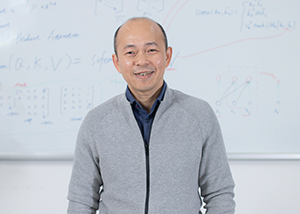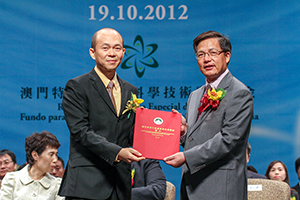Wong Fai: PCT Facilitates the Transition of Macao
黃輝:「中葡通」協助澳門回歸過渡
17 Dec 2019
 Prof Wong Fai
Prof Wong Fai黃輝教授
 Prof Wong Fai's team receives the Science and Technology Progress Award at the first Macao Science and Technology Awards ceremony
Prof Wong Fai's team receives the Science and Technology Progress Award at the first Macao Science and Technology Awards ceremony黃輝教授的研究團隊獲首屆澳門科技獎技術進步獎
In 1999, the year Macao returned to China, the world's first Chinese- Portuguese electronic dictionary (PCT) was launched at the University of Macau (UM) and Prof Wong Fai became a pioneer in machine translation research in Macao. This year marks the 20th anniversary of Macao's handover. Prof Wong and his team have yet again created a new record in machine translation—they developed UM-CAT, the world’s first online Chinese-Portuguese-English computer-aided translation platform.
Facilitating the Transition of Macao
A veritable epoch-making technology, PCT has served the first government of the Macao Special Administrative Region and the private sector in the translation of a substantial number of documents. Developing a machine translation system is in essence a process of teaching the machine to ‘understand’ and ‘contemplate’ language, which is one of the greatest challenges in the development of artificial intelligence technology. Before Macao’s return to China, research in this area was virtually nonexistent. Soon after the launch of the e-dictionary, more than 800 government departments and private companies became registered users. ‘Before the handover of Macao’s sovereignty to China, a large number of official documents needed to be translated, but there was no software or system to aid the translation, so the development of the first e-dictionary was driven by a practical need,’ says Prof Wong.
In 2007, during his visit to UM, then Portuguese President José Sócrates praised the university for its achievements in Chinese-Portuguese translation studies, which he believed would promote friendship and collaboration between China and Portugal. In 2009, UM established the Natural Language Processing & Portuguese-Chinese Machine Translation Laboratory (NLP2CT) and appointed Prof Wong as its director. The machine translation systems developed by UM over the years have indeed greatly facilitated Sino-Portuguese communication in business and cultural affairs.
Growing with UM
Prof Wong entered UM in 1991 to study software engineering. ‘I cherished the opportunity to study at UM because back then it was already the best university in Macao,’ he says. In 1995, he was recommended by UM to study at the Institute of Systems and Computer Engineering (INESC in its Portuguese acronym), a scientific research institution in Portugal, for his outstanding academic performance. At the INESC, he was responsible for developing a geographical information system for the Portuguese military. He returned to Macao the following year and was appointed by UM as a principal investigator for a research project on Chinese-Portuguese machine translation, jointly conducted by UM and Tsinghua University.
Prof Wong believes that the transitional period leading up to Macao’s handover provided the perfect conditions for his team to develop cutting- edge technology in order to create the world’s first Chinese-Portuguese machine translation system. He explains, ‘First, unlike machine translation between Chinese and English, technologies for machine translation between Chinese and Portuguese were virtually nonexistent. So we had to start from scratch and develop many core technologies by ourselves. Second, this is an interdisciplinary research area that involves computer science and language. Fortunately, UM had strong resources in both fields. Faculty members and students from the Department of Portuguese were involved in the entire process, from data input to proofreading and testing.’ Looking back, Prof Wong notes that UM has played a crucial role in cultivating professionals in machine translation. ‘Most of those who are now working in manual or machine translation that involves the Portuguese language in Macao or mainland China either graduated from UM or have been trained by our graduates,’ he says.
Next Goal: Voice Translation
The year 2019 marks the 20th anniversary of Macao’s handover to China. This year, Prof Wong and his team from the NLP2CT launched UM-CAT – the latest Chinese-Portuguese-English online translation system that can effectively assist professional translators by producing smart full- text translation with a high degree of accuracy. The team’s next goal is to tackle the challenge of voice translation between Chinese and Portuguese. ‘As a spin-off of machine translation, voice translation is considered to be the most commercially promising area in the next five years,’ says Prof Wong. Currently, the NLP2CT is working to develop a smart conference translation system that can accurately identify and translate the languages used in a multilingual conference to enhance the efficiency of the conference process. The system is expected to be launched for the mass market in the near future.
1999年澳門回歸那年,全球首部中葡電子辭典在澳門大學誕生,澳大科技學院副教授黃輝成為澳門機器翻譯研究的第一人,為協助澳門回歸過渡作出了貢獻。今年澳門回歸20年之際,他與團隊發佈最新的「在線中葡英輔助翻譯平台」(UM-CAT),全力將知識轉化成產品,讓社會大眾受益。
協助澳門回歸過渡
「中葡通」這一劃時代產物,輔助首屆澳門特區政府和民間機構處理海量有待翻譯的文件。賦予機器翻譯技巧,無異於要機器「能理解、會思考」語言,是人工智能技術中最難研發的課題之一,澳門回歸前沒有這方面的研究基礎。當時,黃輝教授的辭典一推出,就有800多個政府部門及企業註冊使用。「回歸前,澳門有大量官方文件有待翻譯,但卻沒有任何軟件、系統去輔助翻譯,因此有需要開展相關項目的研發。」
2007年,時任葡萄牙總理蘇格拉底訪問澳大,讚揚澳大中葡雙語翻譯研究的成果,相信研究有助推動中葡友好合作。2009年,澳大成立「自然語言處理與中葡機器翻譯實驗室」(NLP2CT),由黃教授出任主任。今天,澳大多項機器翻譯研發已大力推動了中葡翻譯工作,有助中葡經貿文化交往。
與澳大同步成長
1991年,黃輝考入澳大,修讀軟件工程,他回憶道:「那時澳大已是澳門最高的學府,因此很珍惜當時入學的機會。」1995年,他以優秀成績獲澳大推薦到葡國科研機構INESC深造,負責為葡國軍方基地開發地圖資訊管理系統。1996年,黃輝回澳,並以澳大主要研究員的身分,聯合清華大學展開中葡機器翻譯的研究。
黃教授相信,他的研究團隊是充分利用了澳門回歸前的「天時地利人和」,秉持著對前沿科技的追求,創新開發了中葡機器翻譯技術平台。「首先,與中英機器翻譯不同,中葡機器翻譯素材是一片空白,很多核心技術都需要自己一手一腳研發。其次,這是交叉學科的研究,離不開電腦和語言這兩大專業,當時澳大就有此優勢,人文學院葡文系師生從開發到資料輸入、校對和測試,都緊密參與。」回首這20年,澳大在培育機器翻譯人才上功不可沒,「不論澳門或內地,大家都知道大多從事葡文翻譯、機器翻譯的,都是澳大的徒弟,甚至徒孫。」
瞄準語音翻譯
2019年,澳門回歸20週年之際,黃教授與NLP2CT團隊推出「在線中葡英輔助翻譯平台」(UM-CAT),為中葡英雙語或三語互譯提供更專業、準確性更高的全文智能翻譯。團隊下一個目標是攻克中葡英語音翻譯領域。「語音翻譯也被認為是未來五年內最具商業潛力的。」黃教授透露,NLP2CT正積極研發「會議智能翻譯系統」,可滿足多場景同傳交互體驗,相關系統預計不久可供大眾使用。
